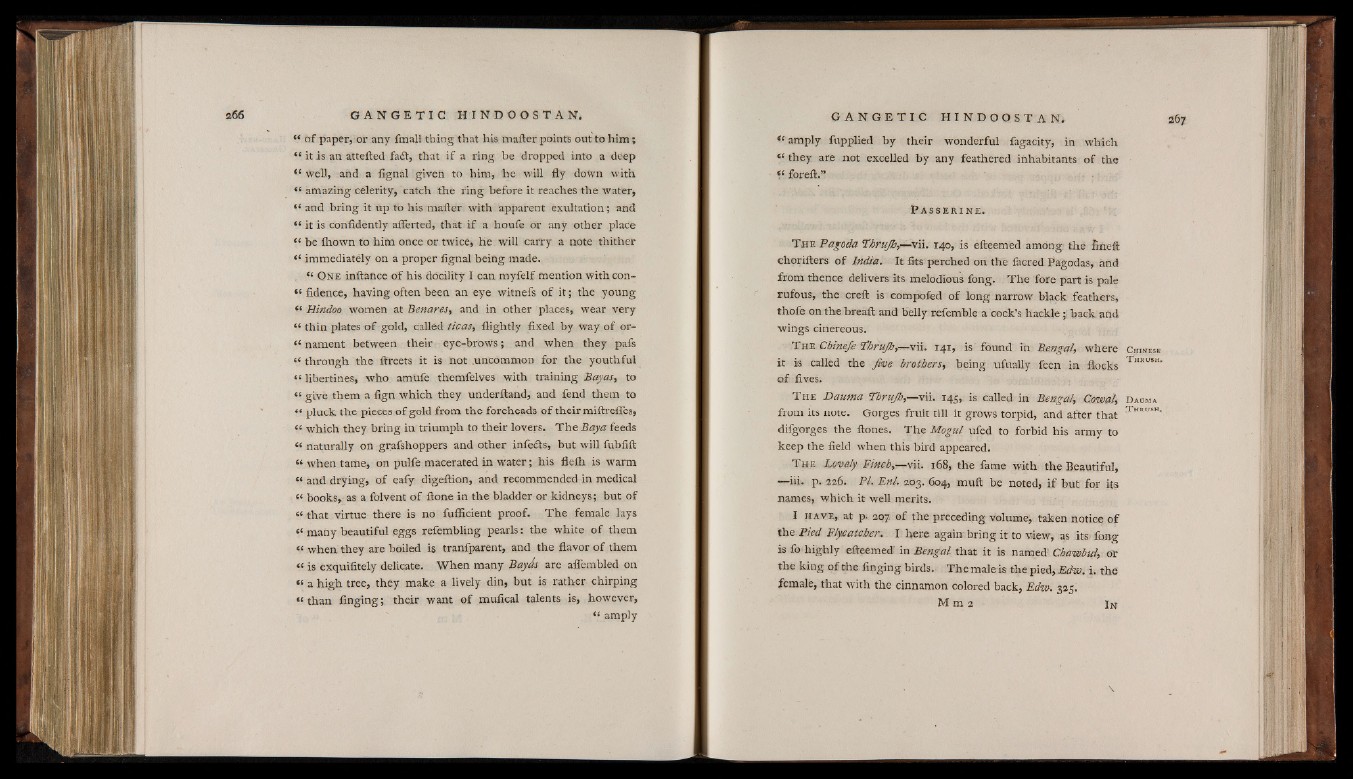
“ of paper, or any fmall thing that his mailer points out to him ;
“ it is an atteiled fadt, that i f a ring he dropped into a deep
<! well, and a iignal given to him, he will fly down with
“ amazing celerity, catch the ring before it reaches the water,
“ and bring it up to his mailer with apparent exultation; and
“ it is confidently aflerted, that i f a houfe or any other place
“ be Ihown to him once or twice, he will carry a note thither
“ immediately on a proper fignal being made.
“ O n e inftance of his docility I can myfelf mention with con-
“ fidence, having often been an eye witnefs of it; the young
“ Hindoo women at Benares, and in other places, wear very
“ thin plates o f gold, called ticas, flightly fixed by way of or-
“ nament between their eye-brows; and when they pafs
“ through the llreets it is not .uncommon for the youthful
“ libertines, who amufe themfelves with training Bayas, to
% give them a fign which they underftand, and fend them to
“ pluck, the pieces of gold from the foreheads of their miilrefles,
“ which they bring in triumph to their lovers. The Bay a feeds
% naturally on grafshoppers and other infeits, but will fubfift
“ when tame, on pulfe macerated in water; his flelh is warm
“ and drying, o f eafy digeition, and recommended in medical
“ books, as a folvent of ftone in the bladder or kidneys; but o f
“ that virtue there is no fufficient proof. The female lays
“ many beautiful eggs refembling pearls: the white of them
“ when they are boiled is tranfparent, and the flavor of them
“ is exquifitely delicate. When many Bayas are aflembled on
“ a high tree, they make a lively din, but is rather chirping
“ than finging; their want o f mufical talents is, however,
1 amply
“ amply fupplied by their wonderful fagacity, in which
“ they are not excelled by any feathered inhabitants of the
“ foreil.”
P a s s e r i n e .
T h e Pagoda Phrufh,—vii. 140, is efteemed among/ the finei:
choriilers o f In d ia . It fits perched on the facred Pagodas, and
from thence delivers its melodious fong. The fore part is pale
rufous, the creil is compofed o f long narrow black feathers,
thofe on the breait and belly refemble a cock’s hackle;; back and
wings cinereous.
The Chine/e cthrujb,— vii. 141, is found in Bengal, where
it is called the five brothers, being ufually feen in flocks
o f fives.
T h e Dauma Tbrujh,—vii. 145, is called in Bengal, Cowal,
from its note. Gorges fruit till it grows torpid, and after that
difgorges the itones. The Mogul ufed to forbid his army to
keep the field when this bird appeared.
T h e Lovely Pinch,— vii. 168, the fame with the Beautiful,
— iii. p. 226. PI. Enl. 203. 604, muft be noted, i f but for its
names, which it well merits.
I h a v e , at p . 207 of the preceding volume, taken notice o f
the Pied Plyaatcber. I here again bring it to view, as .its. fbng
is fo highly efteemed' in Bengal that it is named- Chawbut, or
the king o f the finging birds,. The male is the pied, Edw. i. the
female, that with the cinnamon colored back, Edw-. 325.
M m 2 In
C hinese
T hrush,
D auma
T hrush.